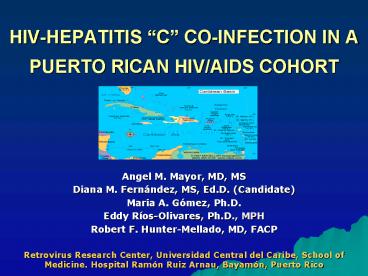HIVHEPATITIS C COINFECTION IN A PUERTO RICAN HIVAIDS COHORT - PowerPoint PPT Presentation
1 / 21
Title:
HIVHEPATITIS C COINFECTION IN A PUERTO RICAN HIVAIDS COHORT
Description:
Diana M. Fern ndez, MS, Ed.D. (Candidate) Maria A. G mez, Ph.D. Eddy R os-Olivares, Ph.D., MPH. Robert F. Hunter-Mellado, MD, FACP ... – PowerPoint PPT presentation
Number of Views:46
Avg rating:3.0/5.0
Title: HIVHEPATITIS C COINFECTION IN A PUERTO RICAN HIVAIDS COHORT
1
HIV-HEPATITIS C CO-INFECTION IN A PUERTO RICAN
HIV/AIDS COHORT
- Angel M. Mayor, MD, MS
- Diana M. Fernández, MS, Ed.D. (Candidate)
- Maria A. Gómez, Ph.D.
- Eddy Ríos-Olivares, Ph.D., MPH
- Robert F. Hunter-Mellado, MD, FACP
- Retrovirus Research Center, Universidad Central
del Caribe, School of Medicine. Hospital Ramón
Ruiz Arnau, Bayamón, Puerto Rico
2
(No Transcript)
3
HEPATITIS C VIRUS
4
INTRODUCTION
- Life expectancy of HIV infected persons has
increase since the introduction of antiretroviral
therapies. - Hepatitis C (HCV) is becoming a great
contributor for HIV morbidity and mortality. - HCV prevalence in USA 2. HCV prevalence in HIV
infected persons 30-50. - HCV transmission Principally by contact with
infected blood (infected needles) and few by high
risk sexual behaviors. - Injecting drug users (IDUS) have a higher risk of
harboring HCV co-infected (Prevalence 50-90). - 80 of the HCV become a chronic infection, of
them 75 develop chronic liver disease and 15-20
develop Liver Cirrhosis.
5
NORMAL LIVER AND CIRRHOTIC LIVER BY HCV INFECTION
6
OBJECTIVES
- Determine the prevalence of Hepatitis C infection
in a cohort of Puerto Ricans HIV/AIDS patients. - Describe the sociodemographic characteristics,
risk profile, HIV clinical manifestations, CD4
and antiretroviral therapy (ART) in the
co-infected patients. - Define the factors that could be associated with
the HIV-HCV co-infection. - Explore the risk factor that increase the
mortality risk of HIV-HCV patients.
7
METHODS
- Population 2,996 Puerto Ricans HIV patients,
followed by the Retrovirus Research Center in the
Universidad Central del Caribe School of
Medicine, at Bayamón Puerto Rico, between January
1992 and December 2001. - Sample 592 HIV infected patients with a positive
ELISA HCV test. - Variables Sociodemographic, HIV risk factors,
HIV clinical manifestations, CD4 cell count ,
ART and mortality data was explored. - Data Analysis Percentage, Fisher, Chi Square and
Cox Proportional Hazard analysis were performed.
8
HCV PREVALENCE IN THE HIV/AIDS COHORT
N2,996
9
GENDER DISTRIBUTION IN CO-INFECTED CASES
n 592
10
AGE, CD4 COUNT AND AIDS AT HCV INFECTION
11
AIDS DEFINE CONDITION PREVALENCE
n592
12
EMPLOYMENT, EDUCATION LEVEL AND HOUSING
13
INJECTING DRUG USE IN CO-INFECTED CASES
n592
14
CLASS OF DRUG USED BY THE CO-INFECTED IDU
PATIENTS
15
MORTALITY RATE BY THE END OF FOLLOW UP
n592
16
MORTALITY RATE DIFFERENCES
17
MORTALITY RISK FOR HIV-HCV INFECTED CASES
BY COX PROPORTIONAL HAZARD
18
CONCLUSIONS
- HIV-HCV co-infection prevalence (20) is lower
than reported in other studies (30-50). An
underreport of cases could explain this issue,
HCV screening test was implement in 1998. - The co-infection is a potential Public Health
problem. - The IDU risk in HIV-HCV patients (80) was higher
than the reported in the whole HIV cohort
(57.2).
19
CONCLUSIONS 2
- High prevalence of unemployment, low formal
education and isolation are common in the group. - Significant mortality increment in patients with
high degree of immunological damage and in
patients with AIDS. - Significant mortality decrement in patients with
Anti Retroviral Treatment.
20
RECOMMENDATIONS
- Active HCV surveillance in HIV/AIDS patients,
for early disease diagnosis. - Primary prevention strategies to reduce the
co-infection , specially in IDU persons. - Secondary prevention strategies to reduce the
hepatic damage. - Early multi ART will improve the immunological
system of the patients, reducing their HIV
morbidity and mortality.
21
ACKNOWLEDGMENTS
- This study was sponsored by RCMI/NIH Grant number
G12RR03035, 1U54RR01950701 and CDC/ASD Grant
number U62/CCU206209































